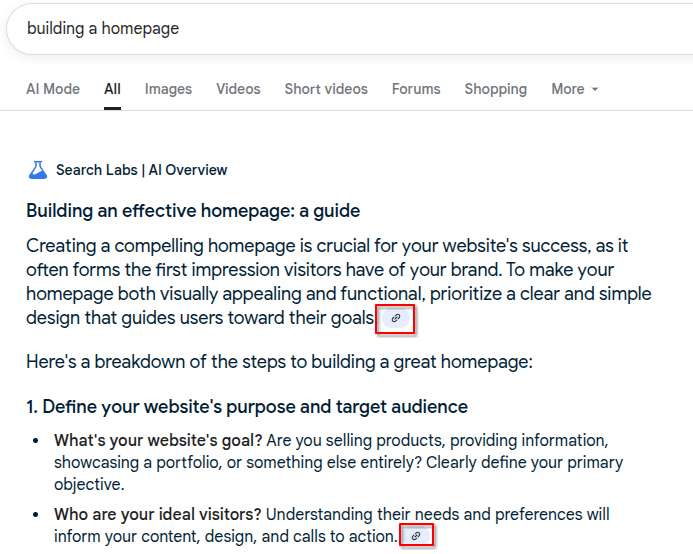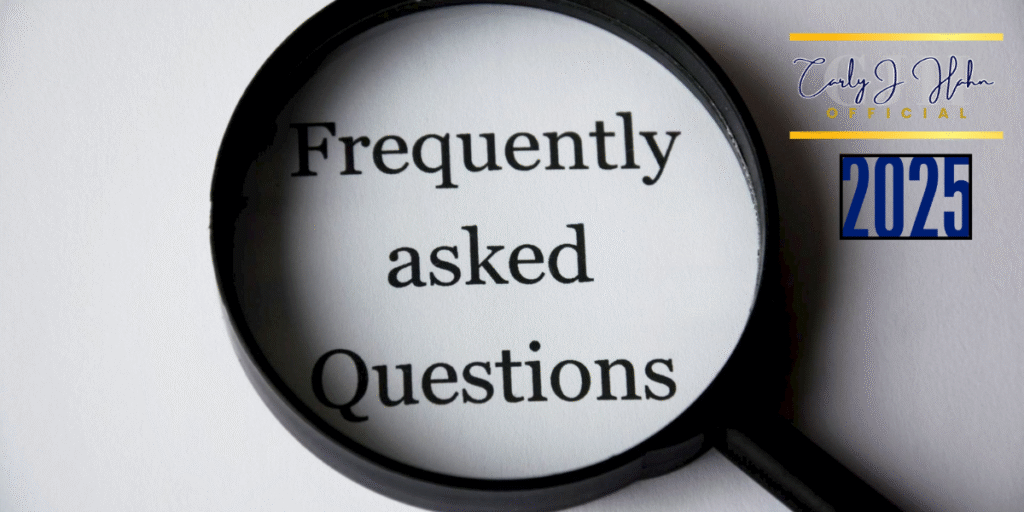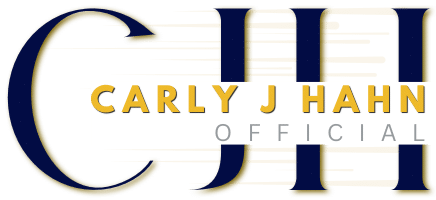Most homepages don’t fail because your service isn’t valuable. They fail because the messaging is off. In 2025, your homepage is no longer just a welcome mat, it’s your digital handshake, your trust-builder, and the first real test of your authority. And now, with AI Overviews pulling content straight from websites, what you write and how you structure it is make-or-break.
In this How to Write a Homepage That Converts article, we’ll walk through a homepage strategy built for real people and modern search engines. If you’re a coach, consultant, creative, or service-based brand tired of vague advice, this is the clarity you’ve been looking for. You’ll learn how to write copy that speaks to your audience’s mind, structure your layout for conversions, and optimize your content so both Google and your ideal client say yes.
Let’s break it down.
Why isn’t my homepage converting?
Your message isn’t clear enough.
Visitors don’t read websites,they scan them. If your headline is poetic but unclear, or your first scroll doesn’t instantly show what you do and who you help, you’ve already lost them. Clarity wins. Confusion kills conversions. Instead of clever metaphors, use straightforward language that mirrors your audience’s actual pain or desired outcome.
You’re not answering their silent questions.
Within the first five seconds, a visitor is asking:
Is this for someone like me?
Can I trust this person?
What’s the next step?
If your homepage doesn’t address those unspoken questions in the hero section or immediately beneath it, the bounce rate will tell the story. You’re not just building interest, you’re building safety.
You’re writing for yourself, not your reader.
Your homepage isn’t about proving credentials. It’s about showing you understand their world. If you’re leading with your résumé instead of their problem, it feels like a monologue. You need a mirror. Write in their voice. Show that you’ve walked in their shoes. Speak directly to the struggle they’re trying to escape, and the outcome they want most.
What makes someone say yes?
It’s not your credentials. It’s your clarity.
People don’t convert because you have a certificate or a clever tagline. They convert because they feel seen. The moment your homepage reflects their internal dialogue, “That’s exactly what I’ve been dealing with”, you earn attention. And attention is the gateway to action.
Your homepage needs to pass the trust test.
Every visitor is subconsciously scanning for three signals:
- Resonance: Do I feel like this person gets me?
- Clarity: Do I understand what they’re offering?
- Confidence: Do I believe they can help me?
You build trust by:
- Using language they already use
- Highlighting real problems and real results
- Showing social proof that’s specific and grounded in outcome
Trust isn’t earned with design alone. It’s earned by showing that you understand where they are and where they want to go, and that you’ve helped others get there, too.
Mirror the pain. Illuminate the possibility.
You’re not just solving a problem—you’re offering a new reality. When you reflect their current pain and position your service as the bridge to a better future, you activate desire. This isn’t manipulation. It’s resonance. And resonance converts.
The Psychology Behind a High-Converting Homepage
You’re not just writing for eyeballs, you’re writing for brains. Specifically, brains that are scanning for answers, safety, and alignment. Here’s how to win them over.
Speak to Pain and Possibility
Every homepage needs to mirror the struggle and offer a way out. When a visitor sees their pain reflected back to them, and then sees a future that feels possible, they stay. And when they stay, they convert. This isn’t about triggering pain for manipulation. It’s about showing what becomes possible when the right solution is in place.
Make It Feel Personal
People want to be seen, not sold to. So skip the generic elevator pitch. Instead, use language that sounds like your audience’s own inner dialogue. Your homepage should feel like a mirror, not a monologue.
Use phrases they’ve said. Reflect the struggles they’ve shared. That resonance builds immediate trust.
Build Micro Trust Quickly
You have less than 8 seconds to prove you’re worth staying for. Testimonials, recognizable logos, trust badges, and specific outcomes do that faster than paragraphs ever could. Use real data, specific praise, and social proof that speaks to results, not just vibes.
How to Write a Homepage That Converts Steps
Use this 6-step framework to structure your homepage for results:
Step 1: Lead with a clear, outcome-driven hero section
Your headline needs to match what someone is already searching for or struggling with. It should state a specific benefit or resolution, not a clever slogan.
Examples:
- “Tired of getting traffic but no leads?”
- “Confused visitors don’t convert. Here’s how to change that.”
Your subheading should support the promise, followed by a button that tells the visitor what action to take next.
Avoid industry jargon, vague phrases, or brand-first language. The job of the hero section is to make the visitor feel understood and point them toward a solution.
Step 2: Build trust through real, measurable social proof
Instead of praise like “they were amazing to work with,” use testimonials that speak to outcomes:
- “We doubled our qualified inquiries within a month.”
- “Our bounce rate dropped by 35% after making changes.”
Whenever possible, include before-and-after snapshots, screenshots, or logos. This reinforces credibility and helps skeptical visitors feel safe taking the next step.
Make sure these examples match the audience you’re trying to attract, industry relevance and result specificity matter more than length.
Step 3: Present your services as solutions, not features
Skip the bulleted list of offers. Instead, frame each service as a response to a common pain point.
For example:
- “Conversion-focused copywriting, so your website doesn’t just look good, it performs.”
- “Content strategy, designed to attract and qualify the right visitors.”
You want the reader to immediately see how each offer solves something they’re already struggling with. When services are positioned as answers, they feel more relevant, and more actionable.
Step 4: Reframe your About section as a credibility builder
Your visitors don’t need your entire background. They need a reason to trust you.
Use this section to speak directly to your audience:
- Who do you help?
- What kind of results do you deliver?
- Why should they believe you can solve their problem?
Keep it personal, but client-oriented. If you include a mission, tie it back to the transformation your work creates—not your personal origin story. One to two short paragraphs is enough.
Step 5: Repeat your primary call-to-action in multiple formats
Most people won’t act on the first CTA they see. Repetition isn’t annoying, it’s clarifying.
Here’s how to do it right:
- Place your CTA after every major section
- Rotate the phrasing slightly, while keeping the action consistent
- Match different decision-making styles (logical, emotional, urgency-driven)
Examples:
- “Start your project”
- “Get expert help”
- “See what’s possible for your business”
All CTAs should drive to the same endpoint, but they should feel fresh and strategically placed based on where the reader is in their journey.
Step 6: Use schema markup to increase visibility in AI search
AI-powered search tools prioritize well-structured, relevant pages. Schema helps machines understand your content and display it more prominently in results.
You don’t need to code. Use an SEO plugin to add:
- WebPage schema: Defines the purpose of your homepage
- FAQ schema: Increases visibility in search overviews
- Organization schema: Links your site to business details
This isn’t about tricking algorithms. It’s about providing structure so your homepage is easier to index, surface, and rank.
Pro tip: include long-tail keywords in your schema descriptions and metadata. Focus on actual questions and phrases your audience would search, not generic keywords.
AI Overviews
With the rise of AI Overviews in Google search, how you structure and phrase your homepage content matters more than ever. This is the mosy important part of the How to Write a Homepage That Converts article.

Here’s why:
AI Is Looking for Clarity, Not Cleverness
AI tools like SGE prioritize clear answers, structured formatting, and semantic relevance. If your homepage is filled with vague or overly poetic language, it won’t surface in AI summaries, or search rankings.
Instead, your content should:
- Echo the user’s query in headlines and body copy
- Use structured H2s and H3s with clear topics
- Avoid industry jargon unless it’s explained simply
This also means AI tools like ChatGPT, Perplexity, and Claude are likely to pull directly from your homepage if it includes:
- Direct answers to common search queries
- Specific services matched to specific problems
- Clear descriptions of who your offer is for
By designing with AI readability in mind, your homepage can act as a primary traffic driver, not just a destination.
Semantic Relevance Is Now a Ranking Factor
Modern search engines, and especially AI-driven search overviews, prioritize pages that directly answer the user’s query with clear, helpful content. This means the words and phrases you use throughout your homepage can significantly impact whether your site shows up in search or gets ignored entirely.
To increase relevance and discoverability, your homepage should naturally reflect the types of questions your ideal audience is asking, such as:
- “What makes a good [industry] website?”
- “How do I know if my [niche] site is working?”
- “What should I put on my homepage for [type of client]?”
- “Best layout for a [service-based/product-based] website homepage”
These long-tail phrases serve two purposes: they match real search behavior, and they guide your content to speak more directly to your audience’s needs. When you include these queries in your copy, particularly in headers, section introductions, and CTA descriptions, you increase the chances of being pulled into AI summaries or top search results.
Just be strategic. Avoid keyword stuffing. Instead, focus on using relevant language that mirrors what your audience is likely to type or say when searching for a solution in your niche.
Your Homepage Is Your Most Important UX Signal
AI is prioritizing pages that offer a helpful, clear user experience from the start. That means your homepage must:
- Load quickly
- Be mobile optimized
- Lead with the primary CTA
- Make your offer instantly clear
These factors aren’t just UX, they’re SEO now, too. In an AI-first internet, usability is not a bonus. It’s the entry fee.
Final Thoughts & FAQs
A homepage that converts doesn’t rely on gimmicks or guilt. It relies on strategy, structure, and deep understanding of what your ideal clients are searching for, literally and emotionally.
When your copy reflects their current problem and offers a path forward, they lean in. And when they lean in, they convert.
If you’re tired of guessing and ready to get strategic, book your Strategy Call.
Let’s fix what’s not working, and turn your homepage into your most profitable asset.
You can follow the Carly J Hahn Official YouTube Channel for more insights.

Why isn’t my homepage converting into leads or sales?
Most homepages fail to convert because the messaging isn’t clear, the layout doesn’t guide the user, or the content isn’t aligned with what the audience is actually searching for. Fixing these elements can dramatically increase conversions. Make sure to bookmark the How to Write a Homepage That Converts article.
What should I include on a high-converting homepage?
A powerful headline, clear value proposition, trust signals, a service preview, and repeated calls to action are all essential. Your homepage should immediately answer who it’s for, what it offers, and what to do next.
How do AI Overviews impact my homepage ranking on Google?
AI Overviews now pull direct answers from websites that are well-structured, helpful, and semantically relevant. If your homepage doesn’t include clear, query-based language and helpful formatting, it may get ignored in AI-driven search results.
What does “semantic relevance” mean for SEO?
Semantic relevance refers to how well your content matches what people are actually searching for, including related terms and follow-up questions. Using these naturally in your homepage copy can boost your visibility in both traditional and AI search.
Do I need to update my homepage for AI search engines like ChatGPT or Perplexity?
Yes. AI-first platforms are indexing websites differently. They prioritize clarity, structure, and helpfulness. A homepage that clearly answers specific user questions has a higher chance of being referenced or ranked.
Should I include my full service list on my homepage?
No. The goal isn’t to overwhelm visitors, it’s to guide them. Use short, benefit-driven previews that reflect real-world struggles your audience is trying to solve. Then direct them to deeper service pages for full details.
How many CTAs should I have on my homepage?
Repetition builds confidence. A homepage should include multiple CTAs, strategically placed after each major section, with varied wording that all lead to the same core action.





